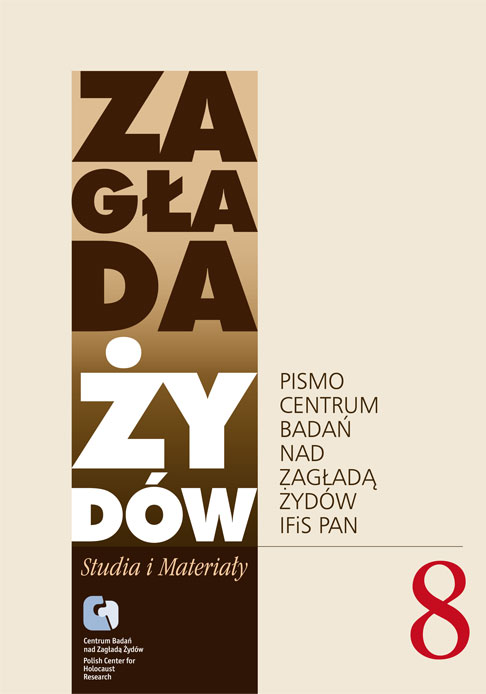Odmienne sylwetki przybyłych do Szwecji więźniów pochodzenia żydowskiego i nieżydowskiego, ocalałych z obozów koncentracyjnych na ziemiach polskich
Zagłada Żydów. Studia i Materiały, Nr 8 (2012), Strony: 419-429
Data zgłoszenia: 2020-12-06Data publikacji: 2012-12-02
 https://doi.org/10.32927/zzsim.698
https://doi.org/10.32927/zzsim.698
Abstrakt
Survivors from Nazi concentration camps, who were brought to Sweden as refugees during the last month of the Second World War and during the summer that followed, were often required to supply information about personal details to the authorities. Much of the information was later stored in written form in the Swedish National Archives. Antisemitism among the refugees and enmity between the Jewish and non-Jewish Polish refugees caused the authorities to include their ethnic or religious affiliation in many records and documents. Using mainly two collections from the Swedish National Archives it is shown that substantial differences existed between Jewish and non-Jewish Polish refugees with respect to their age, education and the length of their war experiences. These differences, in addition to the existing socio-geographic, demographic, cultural and ethnic differences led to inevitable clashes between the two groups. The Swedish authorities who first regarded all refugees of Polish citizenship as one national group had to revise this attitude gradually during the administration of the refugees
Słowa kluczowe
ocalali z Zagłady , Szwecja , stosunki polsko-żydowskie
Licencja
Prawa autorskie (c) 2012 Autor & "Zagłada Żydów. Studia i Materiały"

Utwór dostępny jest na licencji Creative Commons Uznanie autorstwa 4.0 Międzynarodowe.
https://creativecommons.org/licenses/by/4.0
Podobne artykuły
- Anna Bikont, “A young boy attacked us once and started shooting; we didn’t even run any more.” Murders committed on Jews from the village of Strzegom by AK and BCh members , Zagłada Żydów. Studia i Materiały: Nr Holocaust Studies and Materials (2017)
- Arkadiusz Morawiec, Lagry w perspektywie genderowej , Zagłada Żydów. Studia i Materiały: Nr 6 (2010)
- Karolina Panz, “Why did they, who had suffered so much and endured, had to die?” The Jewish victims of armed violence in Podhale (1945–1947) , Zagłada Żydów. Studia i Materiały: Nr Holocaust Studies and Materials (2017)
- Bartłomiej Krupa, Jerzy Kwiatkowski, 485 dni na Majdanku, Lublin: Państwowe Muzeum na Majdanku, 2018, 440 s. , Zagłada Żydów. Studia i Materiały: Nr 14 (2018)
- Jacek Walicki, Zygmunt Messing – dzieje Żyda o życiorysie niezgodnym z regułą , Zagłada Żydów. Studia i Materiały: Nr 8 (2012)
- Jacek Leociak, O nadużyciach w badaniach nad doświadczeniem Zagłady , Zagłada Żydów. Studia i Materiały: Nr 6 (2010)
- Ewa Wiatr, Kawalerowie Krzyża Żelaznego w getcie łódzkim , Zagłada Żydów. Studia i Materiały: Nr 8 (2012)
- Marta Ciesielska, „Dużo trudu i dużo piękna w życiu internatu”. Z Domu Sierot Janusza Korczaka , Zagłada Żydów. Studia i Materiały: Nr 8 (2012)
- Nawojka Cieślińska-Lobkowicz, Polskie. Żydowskie. „Pożydowskie”. Nazistowska grabież dzieł sztuki i problemy restytucji w Polsce 1945–2000 , Zagłada Żydów. Studia i Materiały: Nr 16 (2020)
- Jacek Leociak, Stanisław Śreniowski, z księgi obłędu i ohydy , Zagłada Żydów. Studia i Materiały: Nr 1 (2005)
<< < 14 15 16 17 18 19 20 21 22 23 24 25 26 27 28 29 30 31 32 33 34 35 36 37 38 39 40 41 42 > >>
Możesz również Rozpocznij zaawansowane wyszukiwanie podobieństw dla tego artykułu.
 English
English
 Język Polski
Język Polski








